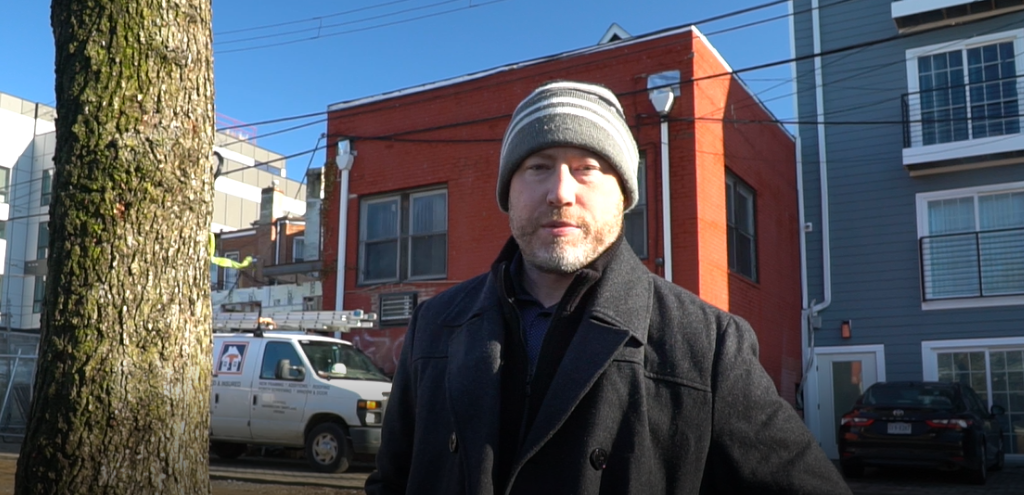THE LEAFLET

Talking Trees with John O’Neill
Here at Casey Trees, we work very closely with the District Department of Transportation’s (DDOT) Urban Forestry Division. Last time we spoke to John O’ Neill, he was working on a story map to help identify and understand trees and their history. Now, John is back to discuss his current projects and how he’s working to protect the District’s tree canopy. Read on to learn about current projects in DC’s Urban Forestry Division.
Casey Trees (CT): Hi John! Could you give our readers a brief background on who you are and what you do?
John O’Neill (JON): I am the lead forester of DDOT Urban Forestry Division. I haven’t always been a lead forester – I started off as a tree trimmer and remover, I was just driving the big trucks around the city and cleaning up tree debris. As soon as I was integrated into DDOT UFD, I learned about Casey Trees, because they’re such an integral counterpart to us and what we do. So, I knew about Casey Trees and how vital it is to maintain the city’s tree canopy, basically, as soon as I started driving those big trucks around.
Day to day I often troubleshoot field problem issues with our field arborist staff, they’ll come to me with issues ranging from enforcement, property boundaries, what’s the law like in this tricky gray area situation – and I’ll use my knowledge of the law to try and help them find an answer.
When I’m not doing that, I’m usually maintaining our intake document for enforcement issues. We usually have several enforcement issues arise every month, people violate the Special Tree Law or the Heritage Tree Law by removing trees without a permit. So, I’ll investigate those issues, find out if we can resolve it in anyway short of issuing an infraction and if we can’t – I’ll write them the notice for infraction, issue it, and be there when we have a hearing at the Office of Administrative Hearings to testify and make sure we hold the violators accountable.
CT: What Projects are you currently working on?
JON: One project currently I’m working on is this one here. We had a report last week of a tree that was topped – where all the canopy is removed from the tree. What we’re seeing here is, I think, a textbook case of topping. Where the tree wasn’t technically removed, because the trunk is still here, but all the canopy was removed. I think we can see that this is a place, in all likelihood, we’re never going to be able to get this canopy back. So, this is a huge loss to the city.
Luckily, this issue came to us, because residents were able to report the issue while it was ongoing – we were able to get field arborist staff out here to collect evidence and get the names of the parties responsible. The next step, in this case, is to get a notice of infraction issued to the tree care company that came in and removed this tree canopy from the city.
CT: Recently, you handled an instance of tree poisoning. Can you tell us about that?
JON: So, the tree poisoning case was one that occurred in Southeast DC on two different properties, where the owners of the properties had used arborist services, we believe, to infiltrate poison into the trees and destroy them. Testing showed the same poisons were found in the trees on two different properties that were owned by the same developer.
Tree law is written and worked as you would expect it to. We found the developer – and after collecting evidence, the developer ultimately just paid the full fine outright, instead of choosing to have a hearing, which was good. So, the money came into the District of Columbia. We can’t get those trees back, but you know, luckily, we can get the word out that even surreptitious actions like tree poisoning won’t go unnoticed by us.
CT: Any advice for aspiring arborists?
JON: Just keep learning. The field of arboriculture is one that’s constantly in flux. What was standard 20 years ago is not the case now, believe it or not. We think of these trees as these ancient, timeless creatures, and to some extent they are, but our understanding of how we relate to them and how we can help them grow in an urban environment is constantly changing. So, keep your eyes open, keep reading new studies, and stay up to date with the current science.
CT: You know we have to ask…What’s your favorite tree?
JON: I think my favorite tree is the Sweet Gum – Liquidambar Styraciflua. I really love the fall colors. I also love the summertime colors. It has a really rich green – and most importantly, I love the fruit, the spiky gumballs. Especially when I was a kid, they were just like, weapons laying around that you could use to fight your friends and it’s such a wonderful tree for that reason, because it contributes to those childhood memories.